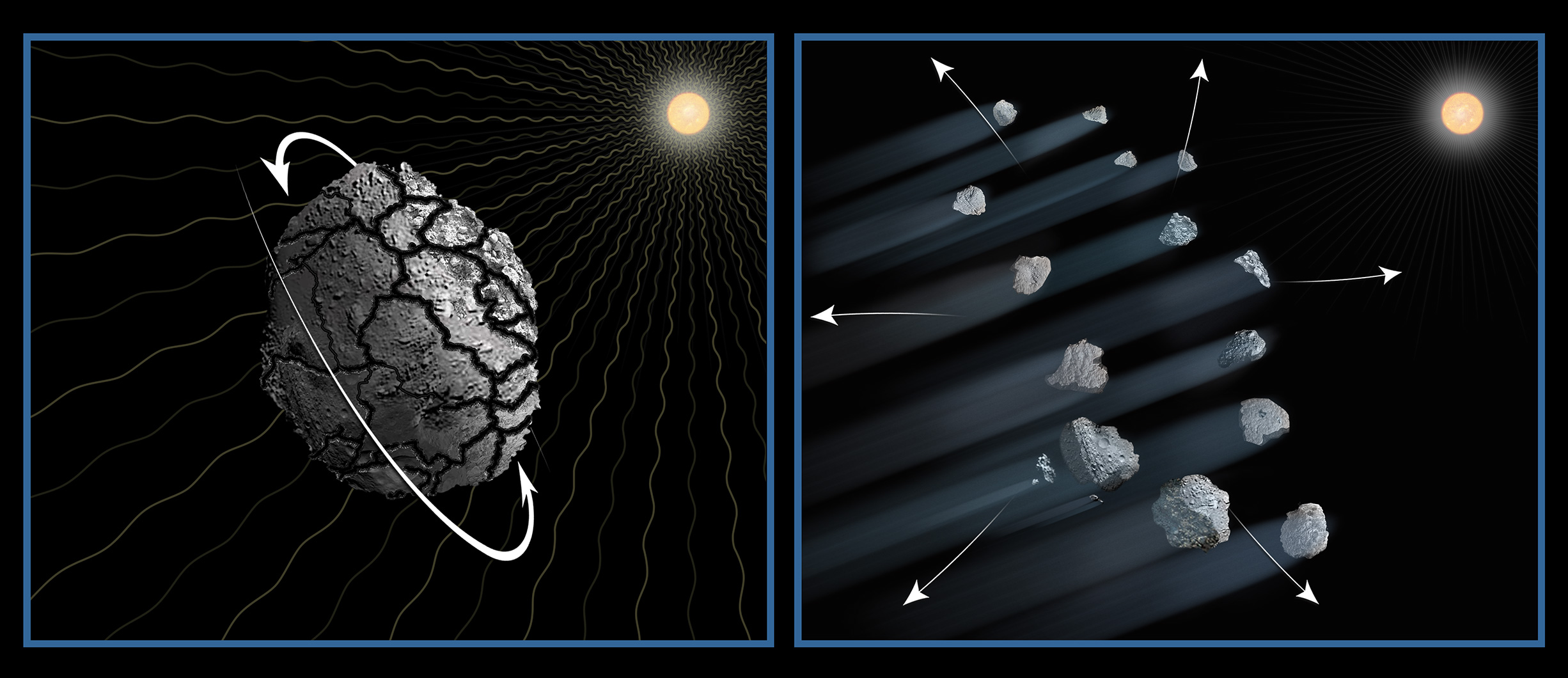Rare Sight: Hubble Telescope Sees Asteroid Falling Apart (Video, Photos)

In a cosmic first, NASA's Hubble Space Telescope has photographed the disintegration of an asteroid in deep space.
Astronomers have seen comets break apart as they near the sun, but they'd never witnessed anything similar in an asteroid in the main belt between Mars and Jupiter — until now. Hubble images show that the asteroid, known as P/2013 R3, has fragmented into as many as 10 pieces. Scientists created a video of the rare asteroid P/2013 R3' breakup based on the Hubble views to chronicle the space rock's demise.
"This is a rock. Seeing it fall apart before our eyes is pretty amazing,"study lead author David Jewitt of UCLA said in a statement. [See more Hubble Photos of Asteroid P/2013/R3 Falling Apart]
P/2013 R3 was discovered in September 2013 by the Catalina and Pan-STARRS sky surveys. Further observations by the Keck Telescope in Hawaii shortly thereafter revealed three bodies traveling together in an envelope nearly as wide as the Earth, researchers said.
"Keck showed us that this thing was worth looking at with Hubble," Jewitt said.
Hubble's sharp eyes found that P/2013 R3 actually consists of 10 separate objects, each of which sports a dust tail. The four biggest pieces are each up to 660 feet (200 meters) wide, and the space rock debris weighs a total of 200,000 tons, researchers said.
Astronomers continued to observe P/2013 R3 from October through January of this year with Hubble, tracking how the object changed. They determined that the asteroid's fragments are drifting apart at just 0.9 mph (1.5 km/h) — slower than casual walking speed.
Breaking space news, the latest updates on rocket launches, skywatching events and more!
"This is a really bizarre thing to observe — we've never seen anything like it before," co-author Jessica Agarwal, of the Max Planck Institute for Solar System Research in Germany, said in a statement. "The break-up could have many different causes, but the Hubble observations are detailed enough that we can actually pinpoint the process responsible."
For example, the fragments' leisurely drift argues against a recent collision as the cause of the breakup, researchers said. And the disintegration is probably not due to the warming and vaporization of interior ices, as P/2013 R3 is cold and appears to have remained far from the sun for billions of years. (The asteroid orbits about 300 million miles, or 480 million km, from our star.)
Rather, scientists think P/2013 R3's fragmentation is driven by something called the Yarkovsky-O'Keefe-Radzievskii-Paddack (YORP) effect, which describes how sunlight can cause an object's rotation rate to increase over time.
Celestial bodies absorb light from the sun and then re-emit much of this energy as heat. Irregularly shaped objects such as P/2013 R3 emit more heat from some areas than others, causing a tiny imbalance that spins the body up slowly over time. This increased rotation rate likely has caused P/2013 R3's constituent pieces to move apart due to centrifugal force, researchers said.
P/2013 R3 must have a weak, "rubble pile" interior to be susceptible to breakup by the YORP effect. The asteroid probably was battered by numerous collisions with other space rocks in the past, scientists said.
"This is the latest in a line of weird asteroid discoveries, including the active asteroid P/2013 P5, which we found to be spouting six tails," Agarwal said. "This indicates that the sun may play a large role in disintegrating these small solar system bodies, by putting pressure on them via sunlight."
The study was published Thursday (March 6) in the Astrophysical Journal Letters.
Follow Mike Wall on Twitter @michaeldwall and Google+. Follow us @Spacedotcom, Facebook or Google+. Originally published on Space.com.

Michael Wall is a Senior Space Writer with Space.com and joined the team in 2010. He primarily covers exoplanets, spaceflight and military space, but has been known to dabble in the space art beat. His book about the search for alien life, "Out There," was published on Nov. 13, 2018. Before becoming a science writer, Michael worked as a herpetologist and wildlife biologist. He has a Ph.D. in evolutionary biology from the University of Sydney, Australia, a bachelor's degree from the University of Arizona, and a graduate certificate in science writing from the University of California, Santa Cruz. To find out what his latest project is, you can follow Michael on Twitter.



